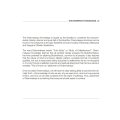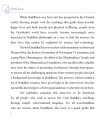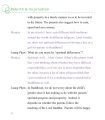Theravāda Buddhism : ค้นหาหนังสือธรรมะ หน้า 3 / 3
หน้าหนังสือทั้งหมด

5
A Comparative Study on Patterns of Mind Development in Thai Society
ธรรมหาธรรม
วาสนาวิชาการทางพระพุทธศาสนา ปีที่ 6 ฉบับที่ 1 (ฉบับรวมที่ 10) ปี 2563
A Comparative study on Patterns of Mind Development of Five Meditation Lineages in Thai Society
Phramaha Wutthichai W
งานวิจัยนี้มีวัตถุประสงค์ 3 ประการ ได้แก่ การศึกษาหลักการพัฒนาจิตตามพระไตรปิฎกเถรวาท การศึกษาการพัฒนาจิตในลัทธิสมาธิ 5 ลัทธิในสังคมไทย และการเปรียบเทียบรูปแบบการพัฒนาจิตในลัทธิสมาธิทั้ง 5 งานนี้ใช้เอก

191
Appendixes of Theravada Buddhism
Part Seven: Appendixes
Theravada: "the Doctrine of the Elders"; considered as
"Orthodox" Buddhism
Tripitaka: The Pali Canon; Source of Buddhist Scriptures
dating back to the time of the Buddha
Tilakkh
This section provides definitions and explanations of key terms related to Theravada Buddhism. It includes insights into the Tripitaka, the Pali Canon which is the primary source of Buddhist scripture

210
Pali Literature: A Comprehensive Guide
Jayawardhana, Somapala. 1994. *Handbook of Pali Literature*. Colombo: Karanaratne and Sons Ltd.
Macdonell, Arthur. 1974. *A Sanskrit Grammar for Students*. Delhi: Motilal Banarsidass.
Malalasekera,
This collection includes essential works on Pali literature and languages, covering texts from Jayawardhana, Macdonell, and Malalasekera. Academic articles discuss aspects such as external sandhi in P

33
Exploring Buddhist Texts and Influence
Bernhard, Franz.
1970 "Gåndhārī and the Buddhist Mission in Central Asia." Ánjali: Papers on Indology and Buddhism: A Felicitation Volume Presented to Oliver Hector de Alwis Wijesekera on His Sixtieth
This collection of works explores the significant contributions to Buddhist scholarship, including analyses of the Gåndhārī texts, the investigation of the Därșanatika, and the characteristics of the

19
Exploring Ancient Thai Meditation Manuscripts and Their Influence
of the original content of the palm-leaf manuscript is provided along with a translation into modern Thai and English. It consists of a correlation of body parts with the sublime attributes of the enl
This content discusses the significance of ancient Thai palm-leaf manuscripts, especially those of the bŏran kammaṭṭhān type, which correlate body parts with Buddha's attributes and suggest daily rec

96
The Imminent Extinction of Palm-Leaf Manuscripts in Sipsong Panna
…nd the management of the production of palm-leaf manuscripts.
There is no central authority in Dai Theravāda Buddhism, and individual temples are largely autonomous. As a result, there is no one central location where…
This text discusses the worrying decline of palm-leaf manuscripts in Sipsong Panna, where Buddhist manuscript culture is rich but facing imminent extinction. Key reasons include the autonomous nature

137
พระมงคลเทพมุนีและการศึกษาพระธรรมในเอเชียตะวันออก
陳慧:“除持入經註(No. 1694 陳慧攷)in Vol. 33。” Taishō Shinshū Daizōkyō
(大正新修大藏經), November 28, 2011. http://21dzk.lu-tokyo.ac.jp/SAT/ddb-sat2.php?mode=detail&useid=1694_33,0011b1 8&key=%E6%81%AF%E4%B8%AD%E5%85
บทความนี้สำรวจการศึกษาพระธรรมที่เกี่ยวข้องกับพระมงคลเทพมุนีและรวมถึงแหล่งอ้างอิงจากผลงานที่มีความสำคัญในพุทธศาสตร์เอเชียตะวันออก ทั้งนี้การให้ข้อมูลดังกล่าวมีเพื่อส่งเสริมความเข้าใจในหลักธรรมและประวัต

195
Understanding the Three Characteristics of Buddhism
Characteristics (tilakkhana), consisting of impermanence
(aniccata), suffering (dukkhata), and non-self (anattata). This
truth stands behind all living beings in this world.
The truths of the Law of K
This text explores the Three Characteristics of Buddhism—impermanence, suffering, and non-self. It discusses how misconceptions among children regarding Buddhist teachings and monks can hinder their u

180
The Decline of Buddhism: Insights from a Senior Monk
When I reviewed my notes from a sermon given by a respected senior monk during my research for this book, I incidentally came upon a valuable message. That is, “What is the most significant cause of B
During research for this book, reflections on a sermon by a senior monk reveal insights into the decline of Buddhism. The monk emphasizes that Buddhism's decline does not occur on its own, but rather

131
Eastern Han Buddhist Meditation and Daoism
Eastern Han Buddhist meditation and Daoism
By the middle of the first century CE, a Buddhist community was already in existence in China, and growing. The arrival of translators from Central Asia and
By the first century CE, Buddhism had begun to take root in China, with translators arriving from Central Asia and India to convert texts into Chinese. They initially faced challenges in accurately co

561
Early Influences and Studies in Buddhism
Bumbacher, Stephan Peter. 2007. "Early Buddhism in China: Daoist Reactions." In A. Heirman and S. P. Bumbacher, eds., *The spread of Buddhism*, pp. 203-246. Leiden: Brill.
Chandawimala, Rangama. 2013.
This compilation examines significant scholarly works on early Buddhism, including Stephan Bumbacher's study of Daoist reactions to Buddhism in China, and Rangama Chandawimala's analysis of the Abhaya

563
Exploring Early Buddhist Texts and Manuscripts
Kandy: Buddhist publication Society.
Dietz, Siglinde. 2007. "Buddhism in Gandhāra." In A. Heirman and S. P. Bumbacher, eds., *The spread of Buddhism*, pp. 49-74. Leiden ; Boston: Brill.
Dutt, Nali
This text includes references to significant works in Buddhist studies, highlighting publications and manuscripts that explore the spread of Buddhism, such as Dias's study on Gandhāra and Dutt's Gilgi

4
Mahāyāna Buddhism: Reasons for Diversity in the Buddha’s Teachings
Here is the extracted text from the image:
---
178
ธรรมาธวก วัตรวรรณวรวิทยาการทางพระพุทธศาสนา
ปีที่ 6 ฉบับที่ 2 (ฉบับสมบูรณ์ที่ 11) ปี 2563
**Mahāyāna Buddhism: Reasons for Diversity in the Budd
เอกสารนี้กล่าวถึงการอยู่ร่วมกันของโรงเรียนพุทธในสมัยพระเจ้าอชาตศัตรู และการยอมรับความหลากหลายของหลักธรรมที่เกิดขึ้น ทำให้เกิดมหายานที่อ้างว่า การเข้าถึงพุทธคติสามารถทำได้โดยทุกคนไม่ว่าจะเป็นพระหรือฆรา

6
วิวัฒนาการของอันตรภาคในพระพุทธศาสนา
ธรรมภาษ วรรณวิชาการทางพระพุทธศาสนา
ปีที่ 7 ฉบับที่ 2 (ฉบับรวมเล่มที่ 13) ปี 2564
บทนำ
พระพุทธศาสนาปฏิรูปสงฆ์ของ “atman” (อาตมัน) หรือ
“atta” (อัตตา) ซึ่งศาสนาพราหมณ์-ฮินดูถือว่าเป็นสิ่งที่เที่ยงแท้
บทความนี้พูดถึงการปฏิรูปของพระพุทธศาสนาเกี่ยวกับคำว่า “atman” และ “atta” ที่เกี่ยวข้องกับกรรมและการเกิดใหม่ พร้อมวิเคราะห์ความหมายของอันตรภาคระหว่างมรณภาพและการเกิดใหม่ ตามความเชื่อในพระพุทธศาสนา โดยอ

61
Understanding Dhammakaya Knowledge
The Dhammakaya Knowledge is taught by the Buddha to constitute the transcendental, blissful, eternal, and pure Self of the Buddha. Dhammakaya doctrines can be found in the scriptures of all major Budd
Dhammakaya Knowledge is a profound teaching from the Buddha that emphasizes the transcendental, blissful, and pure nature of self. This concept is integral to all major Buddhist schools, including The

50
Computerization of the Buddhist Pali Canon
The text in the image reads:
"The Computerization of the Buddhist Pali Canon
With the recognition that many world scholars have been impeded from fully studying the Buddhist scriptures by inconvenie
The Computerization of the Buddhist Pali Canon began in 1984 by the Dhammakaya Foundation to improve access for scholars worldwide. Utilizing the Romanized Pali Canon Text, the project produced a data

206
พระพุทธศาสนามหายานและงานวิจัยเกี่ยวกับพุทธศาสนา
อภิิชย์ โพธิ์ประสิทธิ์ศาสตร์. (2539) พระพุทธศาสนามหายาน. พิมพ์ครั้งที่ 4. กรุงเทพฯ: สภาการศึกษามหามกุฎราชวิทยาลัย มหาวิทยาลัยพระพุทธศาสนา
Bizot, François. 1976. *Le Figuier à Cinq Branches, Recherche
บทความนี้สำรวจการศึกษาเกี่ยวกับพระพุทธศาสนาและภูมิศาสตร์การพัฒนาที่สำคัญ มีการกล่าวถึงเอกสารสำคัญรวมถึงผลงานการวิจัยที่สำคัญในด้านพุทธศาสนา เช่น ธรรมมะและความสำคัญของพระพุทธศาสนาในโลกสมัยใหม่ผ่านมุมมอ

4
Buddha Knows: A Journey into Buddhist Philosophy
Preface
While Buddhism was born and has prospered in the Oriental
world, blessing people with the teachings that guide them towards
happy lives and both mental and physical wellbeing, people from
the
In 'Buddha Knows', Monica Øien interviews Luang Phaw Dhammajayo, the abbot of the Dhammakaya Temple, as he addresses questions from the Western world about Buddhist philosophy. This book serves as a b

20
Rebirth & Incarnation in Buddhism
Rebirth & Incarnation
Monica
with property in a timely manner so as to be invested
in the future. The parents also suggest how to earn,
spend and save money.
: In my travels I have seen different birt
In Buddhism, the gender of a child is not considered important for the spiritual progress of parents. Conversations highlight that responsibilities are not tied to the sex of the child, emphasizing th

120
Buddhism and the Understanding of Life
This question has prompted me to study Buddhism
seriously, which has given me an understanding of life:
1. Death is not the end. We still have to be reborn
indefinitely, as long as we have not rid our
The text reflects on serious studies of Buddhism and how its teachings on rebirth, karma, and consequences of actions shape a more meaningful life. It emphasizes the importance of performing good deed
